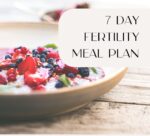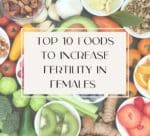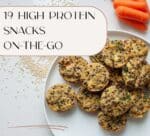Let’s be real, the fertility process sucks!
It can be sterile, clinical, demanding and stressful….very stressful. Let alone all the dates and appointments you have to keep up with, you also have the stress that comes naturally between you and your partner, the stress from friends, coworkers or family and then add in the physical stress of the medications, the timed intercourse, the scheduling and the weight of it all.
The last thing you need is to have to track your calories, avoid foods that give you comfort and be stressed out about the things you enjoy – like eating.
This article is for you!
I want to show you that while eating is necessary for you everyday, eating under stress doesn’t have to be. Here is an easy guide on how to build meals that support fertility, without adding more undue stress to you and your partner’s daily lives.
This way of eating removes elimination diets and restrictions. You can feel good about putting meals together with foods you enjoy and let the nutrients do the rest.
Let these 4 simple steps be your comfort in knowing that you can do this without a lot of effort, it takes the stress out of ‘what is for dinner’ and once you start building meals this way, it’ll be a comfort for you to know that you are getting nutrients you need to support your goals.

Step 1: Start with colourful vegetables.
Start the meal planning process with the idea that vegetables can be the food you consume the most. When you go grocery shopping, look for lots of colourful veggies and fruits. Try a fruit or vegetable that you haven’t tried before. Include as many colours as you can find. Here is a list of colours and a few veggies you may have not tried yet.
- Red: berries, peppers, tomatoes, beets, watermelon radishes
- Orange: carrots, oranges, squash, sweet potatoes, persimmon, papaya
- Purple: eggplant, blueberries, blackberries, purple yam, figs
- White: cauliflower, turnip, parsnip, onion, garlic, kohlrabi, fennel, Jerusalem artichokes
- Green: dark greens, okra, fiddleheads, broccoflower, kale, Brussel sprouts, bok choy
- Yellow: zucchini, pineapple, pears, plantain, grapes, guava, mango, peppers, beans, ground cherries
Different colours = different antioxidants and since there are thousands of types of antioxidants out there, the more you can get, the better for your health. These protect cells from damage, which is crucial for sperm and ovum health.
When building your plate, you are now half done as your plate is best if 50% of it is covered with vegetables.

Step 2: Add a lean protein
Next step is to add a lean protein. Protein is key to maintaining cellular integrity, which means, the ovum or sperm can develop normally. Protein is also required to support of the regulation and flow of the hormone system in both males and females.
Here are some good examples of protein sources that support fertility.
- Beans
- Lentils
- Chicken
- Turkey
- Salmon
- Tuna
- Herring
- Mackerel
- Trout
- Shrimp
- Tofu
- Tempeh
- Greek Yogurt
- Cheese
I do encourage you to try to replace some animal-based proteins with plant-based proteins at least once or twice a week. This change shows support in optimizing fertility outcomes. These are commonly things like beans or lentils.
Fish-based proteins are also healthy options to include 1 -2 x / week. Things like salmon, tuna, herring, mackerel, sardines or trout. See here for some great plant-based and here for great fish-based recipes.

Step 3: Add a whole grain
To balance out your plate, equal the portions of proteins and whole grains. Using whole grains adds additional variety of nutrients and satisfaction to your meals. Things like:
- Brown rice
- Quinoa
- Farro
- Millet
- Barley
- Buckwheat
- Bulgur
- Oats
- Whole wheat bread, pasta or crackers

Step 4: Include healthy fats
Healthy fats are key! These work to increase the absorption of the nutrients in your entire meal. Healthy fats are considered healthy because of their chemical structure and this in turn, effects how our bodies process it. When it comes to fertility and fertility studies, the best studied fat that includes great results is the Extra Virgin Olive oil. This is full of monounsaturated fats that fight inflammation and promote healthy hormones and ovulation.
Other healthy fats include:
- Avocados
- Olives
- Peanut butter
- Nuts – walnuts, Brazil nuts, almonds, cashews
- Seeds – sesame, pumpkin, chia, flax
Use these healthy fats as a topping to your meal. Use 1 to 2 tablespoons as a reference guide when adding healthy fats to your meals.

Summary
Use these four steps to build meals that support your fertility path.
And again – lets be real here! You don’t have to do this every single time you eat! There should never be times where you eat and you feel regret because you didn’t eat a certain way. These steps are simply a guide to help you build your meals when you are ready and feeling up for it. I’m not saying for you to do this every single time you think about eating a meal or a snack but I am giving you recommendations and guidelines that when you are looking to build a meal that supports your fertility journey, that this easy step guide can be one that you refer to for both you and your partner.
If you are looking for more support or have any questions regarding your fertility concerns, feel free to reach out to me via my contact information or DM me through my Instagram feed @Liveandlovenutrition. I’m here to help.
Have a great day!
Cheers!
“May there always be colours on your plate and joy at your table!”





Leave a Reply
You must be logged in to post a comment.